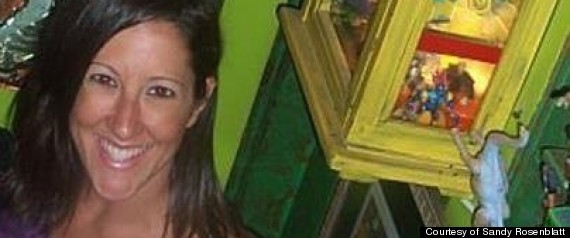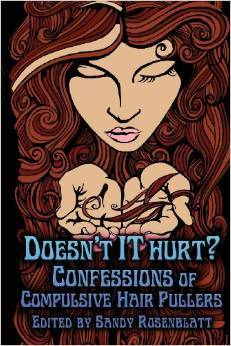Lately, we've seen quite a few young ladies, suffering from Trichotillomania. I thought this story from Sandy would not only be helpful for people experiencing Trich, but for their loved ones too. Luckily, the family members of our Trich clients are so loving and supportive...which is really the only way to be, because being any other way is not helpful to them. William Collier Design understands the shame trich sufferers feel, giving them a safe place to be, to share their condition with no judgement from us. Our rooms our private, and we truly appreciate the opportunity to be a part of their support team. We had a woman in here recently, who started to cry because she was embarrassed, when I asked her to remove her headband to take a look at her hair loss. However, after we found the perfect wig for her, she was smiling as she and her mother walked out the door. When she came back in once her wig was here, and ready for a cut & style she very openly said to William, who she had just met for the first time, "I have trich." I was moved that she felt the security and confidence to just say it right out...that we had created a safe place for her.
Read below, Sandy's story. We hope it helps.
Warmly, Judi
Trichotillomania: The Secret I'm Finally Letting Go
[caption id="attachment_1691" align="alignnone" width="570"] Sandy Rosenblatt, Trichotillomania Disorder[/caption]
Sandy Rosenblatt, Trichotillomania Disorder[/caption]
Who you are looking at in this photo right now is a fraud.
Every day I go to great lengths to hide what I really look like. Every day I make sure you don't see what I do every morning when I wake up and look in my bathroom mirror. Because I have a disorder that an estimated 2-4 percent of the nation has. Few know about it, and even fewer are willing to talk about it.I have Trichotillomania. Trich for short. The disorder causes people to pull out the hair from their scalp, eyelashes, eyebrows, pubic area, underarms, beard, chest, legs or other parts of the body. Hair pulling varies greatly in severity and location, but many times results in noticeable bald patches. Many who suffer from it go through phases in which it presents as very severe, while in others it is barely done at all. My worst phase was between the ages of 7-11.
If you know someone with Trich or you're reading this and finding yourself wanting to ask me, "Why don't you just stop?" -- please don't. It is a question many of us who have the disorder ask ourselves on a daily basis. When asked by someone else, we usually just wait uncomfortably for the subject to change. Here is the answer: Most of us will never be able to stop. If we could, we would.
Today, at 38, I have no eyelashes on my upper eyelids. I pull them out whenever I'm anxious, sad or stressed. Each morning I spend at least ten minutes meticulously applying heavy black eyeliner before I face the world, so that no one will notice that I don't have real eyelashes. When I'm in a relationship, I find myself sneaking out of bed in the middle of the night to reapply it, so he won't see me without it. I have lived in fear of others discovering my secret. I, like many others with the disorder, carry a lot of shame. I'm ashamed of the hairlessness, and I'm ashamed that I can't stop. I'm also ashamed that I want to hide it. And I make the whole thing mean something about myself. I make it mean that I am ugly, I am unworthy, I am unlikeable, I am unloveable. This is a story I began telling myself when I was 7 years old, when it all started.
When I was 7, my parents got a divorce. My father moved out of the house and my concept of what a family was, was shattered. I began to pull. I had no idea what I was doing or why I was doing it. I only knew it felt good.
At first no one noticed. My secret was still safe. Then, little by little, tiny bald patches appeared on my head. Little by little, I had fewer eyelashes and eyebrows. At some point my parents began to notice, and I remember them asking me why. I was 7 years old for God's sake -- how was this little girl who was once bubbly, energetic and innocent supposed to explain the sudden self-destruction, the sudden desecration of her own body?
I had no answer for them. They took me to doctors and psychiatrists, only to find that there was no explanation for why the disorder starts, and that for most people, there is no cure. (There are treatment options, but as of 2012, most with the disorder will not be cured. Many of us living with it have the luxury of knowing we will always have to battle this).
Then, just as my parents began to have me see a doctor regularly in hopes of ending what many see as self-mutilation, the kids at my school began to notice. The other kids stopped playing with me and began calling me a freak. I started to dread taking the school bus, as I never knew when the older kids would bully me, calling me ugly or chanting, "What's wrong with you, freak?" Sometimes they pushed me down the aisle or onto the floor, and sometimes they kicked me while I was down there. At one point these same kids came to my house and asked me to come out and play. I was thrilled; I thought maybe they'd changed their minds and I was actually being accepted (oh, the innocent mind of a second grader). Instead, they took me around the corner to beat me up. I was alone.
As a child I used to love being in photographs. But around this time, I began to want fewer and fewer of them taken of me. I couldn't even look at the photos my parents had hung on the walls. I also stopped looking in mirrors. I knew who would be there staring back at me -- that person everyone called freak, the girl that had something wrong with her. Why would I want to look at her? No one else did. And when I was old enough, I took those photos down and hid them. I asked my family to never take them out; I never wanted to see them again. Why would I want to be reminded of a time in my life with such painful memories attached? My family obliged. My plan was to never in my lifetime ever see those photos again.
Then recently, something changed. I went through my 20s and most of my 30s consciously, deliberately, determinedly not looking at the pictures, not dredging up the memories. But little by little, perhaps without me even realizing it, I grew up. I grew into myself. Maybe I grew beyond who I was before. I don't know. I do know that as I have grown into a woman I love, I decided to do what I promised myself I would never do: I decided to look at the photos. I chose to no longer avoid what I had kept hidden away for so long.
It was a decision born of the intuitive sense that maybe (fine, likely) there was something there for me. I didn't know what, exactly. A connection to the past, perhaps? An admission that I had really lived through that, that now I was different -- or that in reality I was still the same? Whatever it was, even after I decided to do it, it took me weeks to muster up the courage to actually look at them. Then, the night I finally sat with them, I studied them for hours. One question kept echoing in my mind:
Who was this little girl I was looking at?
I was looking at a little girl who loved to rollerskate with her dad. I was looking at a little girl who loved riding her bike. I was looking at a little girl who used to jump rope with her sister, with two ponytails in her hair that her mother tied with ribbons. I was looking a little girl who was told she was ugly, that she was a freak, that there was something wrong with her. I was looking at a little girl who at some point decided that what everyone else said (aside from her parents and grandmother) was true.
In other words, I was looking at me, and the time in my life when I made a choice. I chose my story: I am ugly, I am unworthy, I am unlikeable. Worst of all, I am unlovable. I chose to live that story for a portion of my life while doing everything I could to prove otherwise. I worked hard to distract people, to make them like me even though I knew I was unlikeable, to make them love me even though I knew I was unloveable. I believed my story, and I lived it out, every day.
But what I realized, looking at those photos again, reliving those memories, was that it was always just a story. It wasn't "true," it was something I made up. Not only that, but I made it up when I was 7. And that story I wrote as a young girl who didn't really know any better but was doing the best she could, was fiction. As an adult, strong and conscious, I found that the story I'd gone around telling myself and others for years ... it just isn't true.
I believe the stories we tell ourselves about ourselves create our lives. They don't necessarily create the circumstances (although I believe they do affect them in deep and profound ways), but they create our experience of our lives. So even if I'd been loved, I hadn't felt loved, because I had the story that I was unloveable. And even if I'd been told I was beautiful, I didn't believe it or feel it, because in my story I was ugly.
So here's a different story: I am a beautiful, passionate, loving woman who will do anything for the people she loves. I am authentic with myself and with others, even when it's uncomfortable or nervewracking. I am a person open to learning and growing. I am a human being, alive and vulnerable and true.
That is my real story. That is who I am.
[caption id="attachment_1692" align="alignleft" width="231"] Sandy Rosenblatt's story - Doesn't it Hurt?[/caption]
Sandy Rosenblatt's story - Doesn't it Hurt?[/caption]
To order Sandy's book click below...